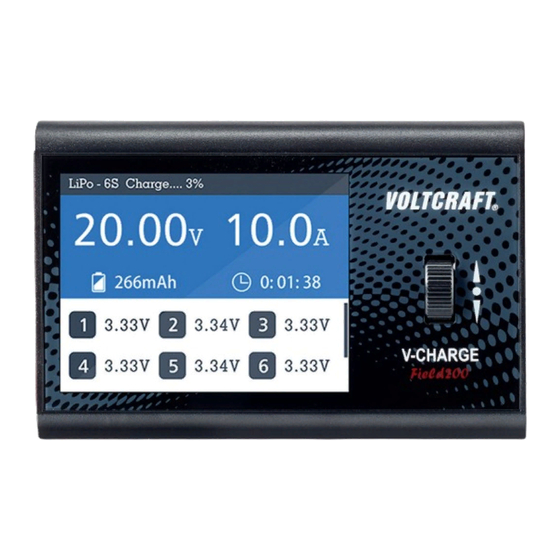Summary of Contents for VOLTCRAFT V-Charge Field 200
- Page 1 Operating instructions V-Charge Field 200 multifunctional charger Item No. 1688224...
-
Page 2: Table Of Contents
Table of contents Page Introduction ................................3 Explanation of symbols ............................3 Intended use ................................4 Delivery content ..............................4 Safety instructions ...............................5 Notes on rechargeable batteries ..........................6 a) General information ............................6 b) Additional information on lithium rechargeable batteries ................7 Overview of parts ..............................9 Setup ...................................9 Operation ................................10 a) Main display ..............................10... -
Page 3: Introduction
Voltcraft offers you reliable technology at an extraordinarily favourable cost-performance ratio. ® We are confident that starting to use Voltcraft will also be the beginning of a long, successful relationship. ® We hope you enjoy your new Voltcraft product! ®... -
Page 4: Intended Use
3. Intended use The processor-controlled charger is intended for charging and discharging NiCd/NiMH (1 – 16 cells), LiPo/Li-ion/LiFe/ LiHV (1 – 6 cells) rechargeable batteries and lead-acid rechargeable batteries (1 – 12 cells, 2 V – 24 V). The charging current can be set between 0.1 A and 10.0 A. -
Page 5: Safety Instructions
5. Safety instructions These instructions contain important information on how to use the multimeter correctly. Please read them carefully before using the multimeter for the first time. Damage caused due to failure to observe these instructions will void the warranty. We shall not be liable for any consequential damage. -
Page 6: Notes On Rechargeable Batteries
• Place the device in a secure place so that it is absolutely secure and cannot fall down! Otherwise, this could cause injuries. Never place the charger and the rechargeable battery on a flammable surface (e.g. carpet). Always use a suitable, non-flammable, heatproof surface. •... -
Page 7: B) Additional Information On Lithium Rechargeable Batteries
• Non-rechargeable batteries are meant to be used once only and must be disposed of properly when empty. • Only charge rechargeable batteries that are suitable for this purpose and use a suitable battery charger. • Rechargeable batteries must not be wet or damp. •... - Page 8 • These instructions must also be followed when inserting or removing the rechargeable battery from the model. • Make sure that the rechargeable battery does not overheat during use, charging, discharging, transport and stor- age. Do not place the rechargeable battery near heat sources (e.g. model control, motor) and protect it from direct sunlight.
-
Page 9: Overview Of Parts
7. Overview of parts 1 Graphical display 2 Adjusting wheel with sensor function 3 Input power supply XT60 (9 – 32 V/DC) 4 PC Link interface 5 Balancer terminal block 6 Ventilation openings 7 XT60 charge/discharge output connector 8. Setup When connecting batteries, always observe the polarity and the charging instructions of the battery manufacturer concerned. -
Page 10: Operation
9. Operation Supply the charger with power. The charger will start with a system test and fan test confirmed by a beep. Some presets must be made before operating the charger. To operate the charger, use a knob with press function (2). To select menu items, turn the knob. To confirm the selec- tion, press the knob. -
Page 11: B) "System Setup" System Settings
b) “System Setup” system settings In the system menu, you can make general settings the charger requires for operation. To enter the system menu, press and hold down the knob for approx. 2 seconds. The system menu will be displayed with a beep. The “System Setup”... -
Page 12: C) Program Settings
c) Program Settings In the programme menu, you can preset all parameters for the rechargeable battery care. To enter the programme menu, briefly press (for less than 1 second) the knob. The programme menu will be displayed with a beep (unless the beep has been disabled in the system menu). -
Page 13: Connecting The Rechargeable Battery And Starting The Programme
Follow the menu selection. Start with the first menu item and then select all other menu items. Make sure that the set parameters match the rechargeable battery before connecting it. The rechargeable battery and the charger may be damaged if the charger is not properly configured. Overcharging may cause an explosion or fire. -
Page 14: C) "Pc Link" Interface
c) “PC Link” interface This interface allows the charger to be controlled and read by a Windows compatible computer. The free “Charge ® Master” software provides all setup functions that can also be set on the device. In addition, you can create and save your own charging/discharge programmes. -
Page 15: Disposal
12. Disposal Electronic devices are recyclable waste and must not be placed in household waste. At the end of its service life, dispose of the product according to the relevant statutory regulations. Remove the inserted batteries and dispose of them separately from the product. Disposal of flat accumulators You are required by law to return all used batteries (battery ordinance). - Page 16 This is a publication by Conrad Electronic SE, Klaus-Conrad-Str. 1, D-92240 Hirschau (www.conrad.com). All rights including translation reserved. Reproduction by any method, e.g. photocopy, microfilming, or the capture in electronic data processing systems require the prior written approval by the editor. Reprinting, also in part, is prohibited. This publication represent the technical status at the time of printing.


















Need help?
Do you have a question about the V-Charge Field 200 and is the answer not in the manual?
Questions and answers